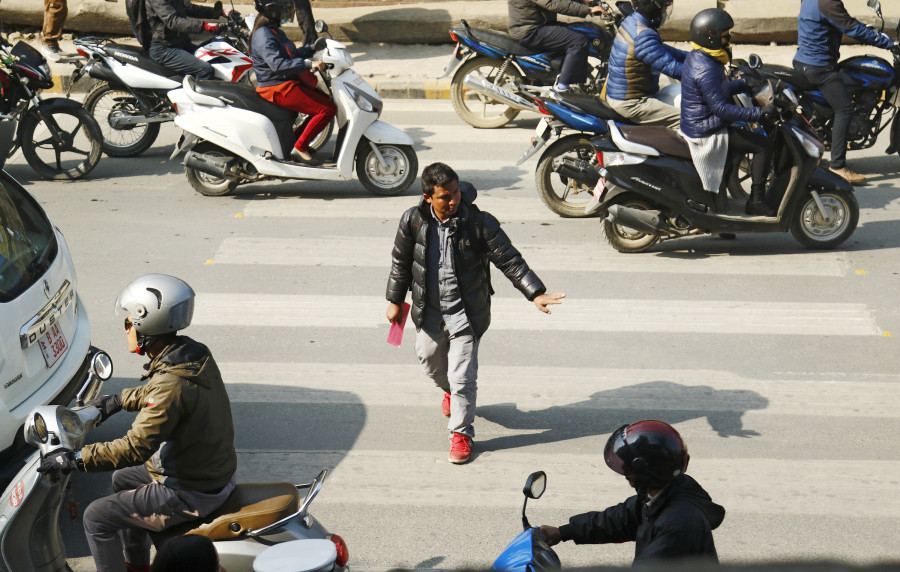Columns
Making Nepal’s roads safer
A concerted effort is required from the government, international partners and road users.
Hartwig Schafer
During my visits to Nepal, I often walked through the busy streets of Kathmandu or looked out the plane window and marvelled at the sight of its magnificent hills, with roads winding across them. And while I always admire the beauty of the country, I also reflect on the perilous journey that Nepalis face on the road every day. Nepal has one of the highest rates of road deaths in South Asia. In 2019 alone, there were nearly 13,000 highway and road accidents with more than 2,700 deaths and 10,000 serious injuries. Road crash deaths and injuries in Nepal have been on a sharp upward trajectory since the early 2000s, as the country invested in increasing road connectivity and economic growth boosted vehicle ownership. The road safety crisis is a growing global epidemic, and Nepal is no exception.
Apart from the enormous human toll, road safety has a significant economic impact. A study by the World Bank in Nepal showed that the financial cost of road traffic injuries has increased threefold since 2007 and is equivalent to 1.5 percent of the gross national product. Road crashes also have a devastating and disproportionate impact on the poor. More than 70 percent of all road fatality victims in Nepal are vulnerable road users like pedestrians, cyclists and motorcyclists. The loss of income and medical expenses from a crash can thrust a family into deep poverty.
Despite the recent Covid-19 lockdowns in Nepal, the number of road-related accidents does not seem to have dropped substantially. At a time when medical resources are already stretched to the limit by the pandemic, road crash injuries further burden the nation’s overstretched healthcare system. Road safety is clearly not just a transportation challenge. It is a development challenge with a substantial impact on health, human capital and economic growth; and we need to act urgently to address these challenges.
The road to safety
The government of Nepal has already taken many positive steps towards ensuring safer roads. Recently, the government revived the inter-departmental National Road Safety Council led by the Ministry of Physical Infrastructure and Transport, as the apex body for road safety in the country. These efforts have been strengthened through an updated Road Safety Action Plan and a comprehensive National Road Safety Bill under consideration in Parliament. Going forward, the government needs to urgently enact the Road Safety Bill, and fully empower the National Road Safety Council to have ownership of the road safety agenda.
Nepal also needs to invest in safe system-based interventions. This includes designing safer roads, improving vehicle standards, deterrence-based traffic enforcement and encouraging positive road user behaviour. This will require bringing together different agencies responsible for road safety, including transport, infrastructure, traffic police, health and emergency care, and education.
Another key priority will be to ensure the adoption of critical standards and regulations and make them at par with global best practices. For example, helmets are one of the most important protective devices when it comes to road safety, given that more than a third of all road crash victims in Nepal are motorcyclists. While helmet usage by riders has become increasingly common, especially in urban areas, pillion rider usage is sporadic. The market is also flooded with uncertified helmets that do not meet international standards. With the road safety law's adoption, newer standards that comply with United Nations recommendations can be uniformly applied across the country, yielding huge safety benefits.
As part of our long-standing partnership with the Ministry of Physical Infrastructure and Transport, we have launched an advocacy campaign to engage Nepali youth on road safety issues, including safe helmet use. As those most affected by this crisis, it is crucial that youths are informed, engaged and active in pushing for road safety. We’ve also joined hands with the UN Special Envoy for Road Safety Jean Todt, the Fédération Internationale de l'Automobile and the Nepal Automobile Sports Association to launch the FIA Safe and Affordable helmet programme to promote awareness of UN-standard helmets that are affordable and certified.
Progress is possible
With commitment and innovative thinking, saving lives on the road is possible. The Ministry of Physical Infrastructure and Transport has embraced road safety as an integral pillar to improve accessibility. The World Bank remains committed to working closely with the government to help achieve the Sustainable Development Goals target of reducing road crash deaths by half by 2030. We are helping Nepal build safe infrastructure, providing technical assistance and building capacity to help achieve its road safety goals.
In 2016, a World Bank project with support from a United Kingdom Aid grant administered by the Global Road Safety Facility installed 73,000 metres of road crash barriers along high-risk sections of 700 km of mountainous roads in Nepal. This intervention won the 2020 Prince Michael International Award for Effective Delivery of Global Road Safety, and is expected to save up to 3,500 lives over the next 20 years. Through World Bank support, sections of the Siddhartha Highway were recently upgraded to include sidewalks and speed-calming to provide safe access to pedestrians and cyclists from adjoining village communities. The government has also improved its crash data management capabilities by developing an online Road Accident Information Management System currently piloted in Kathmandu Valley.
However, the road safety battle cannot be won alone. Addressing these challenges will take the collective action of all stakeholders, including the government, international development partners, private sector, civil society and the road users themselves. As Nepal embraces federalism, it will also be essential to coordinate with local governments to ensure road safety is a shared priority. With the necessary investments, strong political commitment, coordinated interventions and collective action, we can take the high road to safety in Nepal and save countless lives.




 14.12°C Kathmandu
14.12°C Kathmandu















